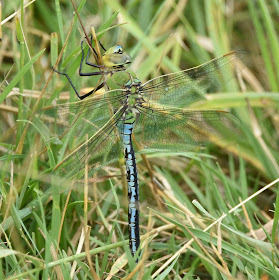 |
| Red Kite and Common Tern (c) Bark |
The moor is beginning to quieten down now, at least in terms
of raucous birdsong, courtship and territorial disputes. There are still
youngsters in and out of the nest to be fed and in some cases second broods to
be created.
 |
| Young Goldfinch and young Blue Tit (c) Bark |
Newly independent juveniles are gathering in mixed feeding flocks and
roving through the hedgerows and scrub.
 |
| Newly fledged Wren (c) Bark |
We are also beginning to see returning waders and the first
of the autumn passage migrants. Last week we recorded the first Common
Sandpiper and first Greenshank of the year. We also had a flyover Siskin on
Saturday morning and I have heard that Siskins have been seen on garden feeders
up in Stanton St John.
 |
| Redstart (c) Nick Truby |
There are at least three male Redstarts on and around
the reserve at present. Two of them are still in the tall broad hedge alongside
the first part of the path out to the Pill.
 |
| Juvenile Whinchat (c) Nick Truby |
A young Whinchat was found in the
same hedgerow, earlier than we normally expect to see them on passage.
 |
| Juvenile Tern on the bank..... (c) Bark |
At the second screen, the two Common Tern chicks that I had
presumed would drown when they fell from the raft are now fully feathered and
flying with their parents, but still returning to the mud bank to be fed on the
ground.
 |
| .......and now flying (c) Bark |
Out on the raft we could see at least six more chicks at differing
stages of development. It was impressive to see how half a dozen Terns could
chase away a Red Kite from the airspace over the lagoon, diving in with what can
only be termed kamikaze attacks.
 |
| Tern Kite aerial battle (c) Bark |
Over Greenaways during the breeding season
Lapwings attempt the same tactic but the Kites ignore them. When the terns go into
the attack they don’t hold back, they really seem to mean it!
It is the turn of the northern lagoon to have water levels dropped
this year and muddy margins are already starting to show out on the right-hand
side. It is well worth watching this area closely, with the reedy edge being
very ragged and sparse. It looks just the area to see Water Rails or as the
season progresses even a Crake creeping about. We saw a Bittern stalking along
the northern edge, disappearing in and out of the reeds, seemingly appearing and
disappearing at will, its plumage is so cryptic.
 |
| Raven (c) Bark |
There is a family party of four Ravens frequenting the moor
and its surrounds. They announce their presence with their characteristic deep cronking,
sometimes flying close together and sometimes calling to each other from a
distance. Their vocalisations sound to be more than just contact calls they
seem to be more of a conversation. While they were flying across Greenaway’s
last week one of the bird performed a series of tumbling manoeuvres. It looked
like an expression of pure exuberance, doing something just because you can.
When they are flying and calling together like that, it is easy to see how they
became a fixture of Norse mythology and significant characters in folklore.
 |
| Top Emperor and below Brown Hawker with a darter lunch ! (c) Bark |
It has been a very good year for Dragonflies and all of the
large species are on the wing now with a supporting cast of smaller Darters and
Damsels. I have seen pristine newly emerged Emperor Dragonflies and last
weekend what I first thought was a mating pair of brown Hawkers, turned out on
closer examination, to be a Hawker consuming a captured Darter. There is no family solidarity!
 |
| Speckled Wood, Holly Blue, Purple Hairstreak and Small Copper (c) Bark |
Bees, Butterflies and Bugs throng to the abundant bramble
flowers and cow parsleys as they open in the sunshine. There are invertebrates
everywhere on the reserve, but the Roman Road is one of the best places to see
the greatest variety.
 |
| Bumble Bee, Soldier Beetle, Long-horned Beetle and a weird Fly!! (c) Bark |
In a few weeks time the Brown Hairstreaks will be on the
wing and will draw in numbers of butterfly enthusiasts to see them. If you look
closely and carefully, whilst waiting to spot the Hairstreaks, you can find all
sorts and shapes of other invertebrates; Long -horned Beetles, Bumble Bees,
Solitary Wasps, Hover Flies, Grasshoppers and Bush Crickets, it is a rich and
varied habitat.
 |
| Young Sedgie (c) Bark |












No comments:
Post a Comment